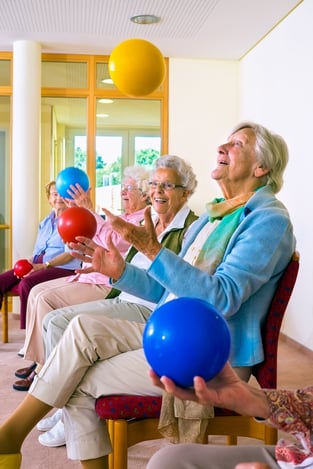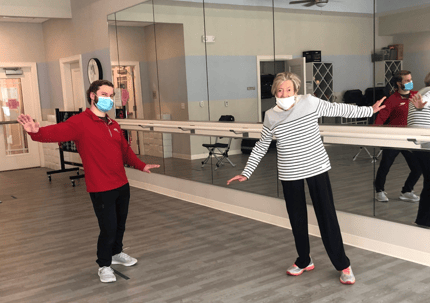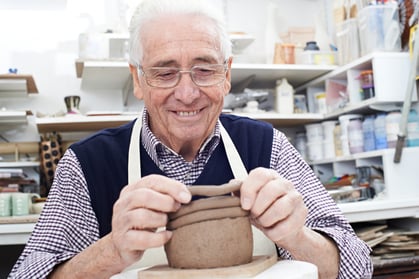 Group exercise classes are one of the top activities in senior living communities nowadays. With the increasing number of activities provided on community calendars, having a good group exercise program significantly impacts the overall resident well-being as they participate in their daily activities.
Group exercise classes are one of the top activities in senior living communities nowadays. With the increasing number of activities provided on community calendars, having a good group exercise program significantly impacts the overall resident well-being as they participate in their daily activities.
The initial spark of having a new group fitness class promotes a tremendous buzz throughout the community, and the new activity on the calendar generates a lot of popularity. Participation is high, and residents look forward to this new class to see what’s in store for them at the next session. A month or so down the road, however, you may notice that the residents who were highly motivated to attend a particular exercise class have begun to feel less interested in the routine, potentially causing a decrease in participation.
When people are acclimated to an established exercise routine, there may come a point where they feel tired of doing the same exercises over and over again, or don’t feel challenged enough in the journey to an improved quality of life. If you begin to notice these things in your exercise programs, it might be time to make some minor adjustments. However, that doesn’t mean that you have to turn your group exercise program on its head and start from scratch. Spice up group fitness routines for seniors and keep them interested.
As an exercise instructor who thinks about these things on a daily basis, one of my primary goals is to encourage participation in our group exercise classes on a regular basis, regardless of their skill level. I actively think of different ways of keeping residents enthusiastic about our classes, while still maintaining their overall purpose. While residents want to exercise safely, they also want to be appropriately challenged so that they don’t lose the benefit of maintaining an active lifestyle.
Following are three different strategies that I have used in the past to keep residents interested in classes.
Mixing Up the Exercises in Your Routines
Adding different exercises into your routines will help keep your residents interested, and can increase cognition as they perform exercises that focus on balance and hand-eye coordination. A good way to map this out is to try one new exercise per class, and see how your residents respond to it. If they find enjoyment in the sequence, you are on the right track! Varying your group exercise sequences every month or two can go a long way in maintaining resident interest.
Another effective strategy that helps in mixing up your routines is to have two or three different formats for one particular class, and to rotate through those formats. I have always found that having a couple routines that I could rotate through on a weekly or monthly basis keeps people more engaged.
Incorporate Music into Your Classes
Whether it’s a choreographed mix-tape that has a variety of upbeat songs for low-impact aerobic routines, or a Big Band CD that is used simply as a background filler for the class, you will notice an immediate increase in residents’ mood in the class, and in some cases they might even get into the groove as the music is playing in class. Having a mixture of upbeat tunes along with songs requested by your residents will keep the excitement going in class. Music can also serve as a motivational factor for residents when they are participating in classes, because exercising to music can have psychological benefits that include improved cognition, reduced anxiety, and many more.
Interactive Exercises
Most people think of group exercise as performing certain routines in a repetitive motion for a certain amount of weight, repetitions, and sets. While in certain class formats that may work, it does not always have to be that way. For most of my exercise classes, I mainly focus on exercises that mirror our activities of daily living (ADLs), and also include sequences that incorporate the mind/body connection. The National Institute for Health (NIH) has an extensive list of various exercises that are both interactive, and ways to focus the class on functionality. Nontraditional balance exercises such as ankle spelling and ball tosses will keep your members guessing both physically and cognitively.
Make sure to use these strategies to spice up your senior living community exercise classes! Keep an open mind when trying out new things in your classes; see what works, and spice things up!
Start with evaluating your balance classes and maximize your Balance Program by downloading our whitepaper!

 The individualized exercise prescription continues to be a strong driver of resident engagement in fitness programming in the senior living communities we serve. The approach is highly personalized and we have helped residents prepare for vacations with the grandkids, train for an upcoming golf season, focus on balance training, and condition for mountain hiking trips. The unique motivations for residents to begin or adapt their exercise routine are always inspiring. I have been working in fitness in the senior living industry for almost 20 years and the resident success stories we hear never get old and always bring a smile to my face. Hearing about individuals reclaiming their independence, achieving new goals, and gaining confidence is powerful and we are fortunate to work in a field that allows us to play a role in these accomplishments.
The individualized exercise prescription continues to be a strong driver of resident engagement in fitness programming in the senior living communities we serve. The approach is highly personalized and we have helped residents prepare for vacations with the grandkids, train for an upcoming golf season, focus on balance training, and condition for mountain hiking trips. The unique motivations for residents to begin or adapt their exercise routine are always inspiring. I have been working in fitness in the senior living industry for almost 20 years and the resident success stories we hear never get old and always bring a smile to my face. Hearing about individuals reclaiming their independence, achieving new goals, and gaining confidence is powerful and we are fortunate to work in a field that allows us to play a role in these accomplishments.
 As the end of 2020 approaches, there are daily reminders that life has changed. For some, these reminders are feelings of loneliness that didn’t exist just a few months ago. Older adults are at the highest level of risk for severe illness from COVID-19 and
As the end of 2020 approaches, there are daily reminders that life has changed. For some, these reminders are feelings of loneliness that didn’t exist just a few months ago. Older adults are at the highest level of risk for severe illness from COVID-19 and  Group exercise classes are one of the top activities in senior living communities nowadays. With the increasing number of activities provided on community calendars, having a good group exercise program
Group exercise classes are one of the top activities in senior living communities nowadays. With the increasing number of activities provided on community calendars, having a good group exercise program 
 We do a lot of wellness consulting in senior living, and by “wellness”, I mean non-clinical, lifestyle-focused consulting. For many of our clients, that consulting relationship involves a thorough review of their “activities” department; in other cases, it’s focused more on what’s happening with their exercise program. Regardless of the original area of focus, we always arrive at the same point – building a strategy that allows the community to shift from filling a calendar toward supporting resident purpose and passion.
We do a lot of wellness consulting in senior living, and by “wellness”, I mean non-clinical, lifestyle-focused consulting. For many of our clients, that consulting relationship involves a thorough review of their “activities” department; in other cases, it’s focused more on what’s happening with their exercise program. Regardless of the original area of focus, we always arrive at the same point – building a strategy that allows the community to shift from filling a calendar toward supporting resident purpose and passion.
